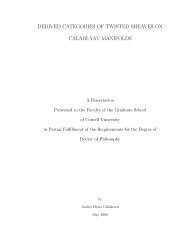Modifications of the Harmonic Series - Department of Mathematics
Modifications of the Harmonic Series - Department of Mathematics
Modifications of the Harmonic Series - Department of Mathematics
You also want an ePaper? Increase the reach of your titles
YUMPU automatically turns print PDFs into web optimized ePapers that Google loves.
4. The <strong>Harmonic</strong> <strong>Series</strong> in Qp<br />
In <strong>the</strong> same way <strong>the</strong> rational numbers are completed to form <strong>the</strong> field <strong>of</strong> real<br />
numbers, <strong>the</strong>y can also be completed to form <strong>the</strong> field <strong>of</strong> p -adic numbers. The<br />
process <strong>of</strong> completing relies upon <strong>the</strong> use <strong>of</strong> a norm. If we use <strong>the</strong> ‘normal’ absolute<br />
value, <strong>the</strong>n when we complete we get . If we use a different norm instead, we<br />
get a completely different field. The field <strong>of</strong> p -adic numbers, p<br />
, is formed by<br />
completing using <strong>the</strong> following norm:<br />
where<br />
x<br />
p<br />
−ord<br />
p ( x)<br />
⎧⎪ p if x≠0<br />
= ⎨<br />
,<br />
⎪⎩ 0 if x = 0<br />
t<br />
⎪⎧<br />
<strong>the</strong> largest t for which p | x if x∈<br />
ord px<br />
= ⎨<br />
.<br />
⎪⎩ ord pa− ord pb,<br />
if x = a / b, a, b ∈, b ≠0<br />
There are two things to note about this norm. First, p must be prime. Second, <strong>the</strong><br />
prime numbers each define a different norm, and <strong>the</strong> fields created with <strong>the</strong> different<br />
primes are not isomorphic to each o<strong>the</strong>r. The 2-adic numbers are quite different from<br />
<strong>the</strong> 7-adic numbers.<br />
21
















